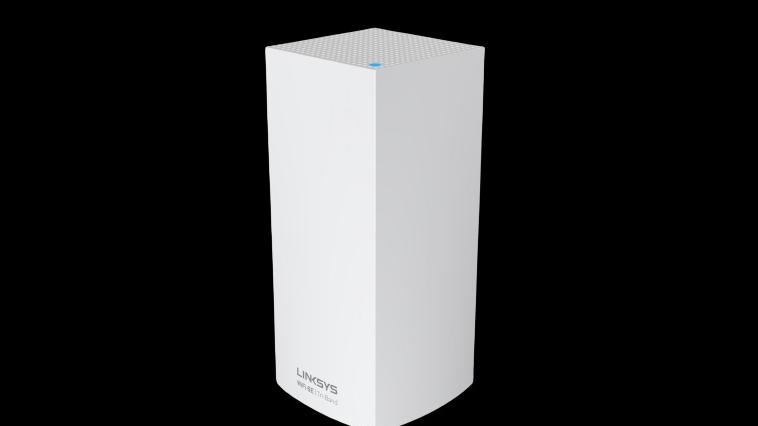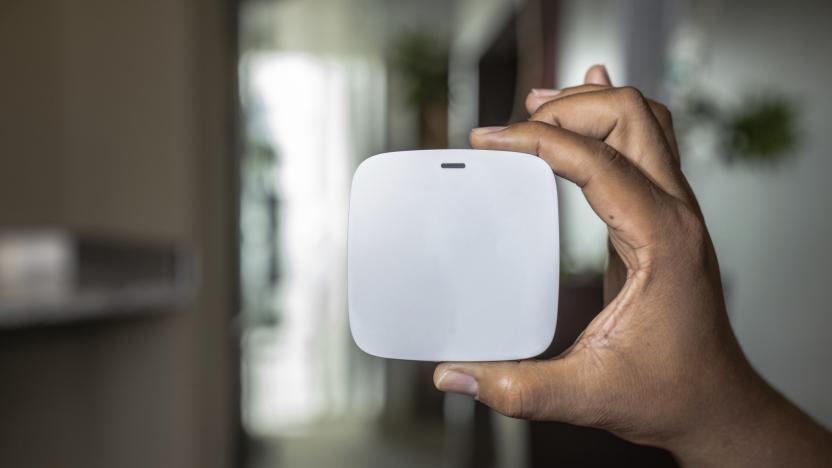mesh network
Latest

Linksys reveals a WiFi 6E mesh system starting at $450
A single AXE8400 node costs $450 and will cover up to 3,000 square feet.

Qualcomm's next-gen mesh network tech supports palm-sized routers
Nodes based on the Immersive Home Platform could flood your home with gigabit WiFi.

Amazon's new Eero mesh routers support WiFi 6
WiFi 6 support was a notable missing feature from Eero's mesh routers, but not anymore.

Amazon's new Eero mesh WiFi system is all about ease of use
You'd be forgiven for not knowing Amazon acquired the mesh-networking outfit Eero earlier this year; routers are less than thrilling by nature, and the deal's potential was less exciting than the problems it caused for existing employees. Amazon was keen to move on, though, so it announced a new version of those Eero routers at its press conference in Seattle today.

Duracell Powermat adding mesh network, scaleable power to its wireless charging plates
Duracell Powermat is announcing a pair of new features to encourage sales of its wireless charging gear. The first is "Mesh Network," a set of controls that let multiple hotspots be centrally monitored -- so if you're stealing all the juice in the Wall St. Starbucks, central office can cut you off. On the upside, those same network features will enable you to find another charging hotspot on your smartphone, including Madison Square Garden and Jay-Z's 40/40 club. The second feature is that the latest mats will be able to vary the power on offer between 5 and 50 watts, making them capable of recharging smartphones, tablets and (potentially) Ultrabooks. Now all we have to do is work out how to power all of our electronics without arousing the suspicions of Jay-Z -- we'd hate to add a 100th problem to his worry list.

Sandia Labs' MegaDroid project simulates 300,000 Android phones to fight wireless catastrophes (video)
We've seen some large-scale simulations, including some that couldn't get larger. Simulated cellular networks are still a rare breed, however, which makes Sandia National Laboratories' MegaDroid project all the more important. The project's cluster of off-the-shelf PCs emulates a town of 300,000 Android phones down to their cellular and GPS behavior, all with the aim of tracing the wider effects of natural disasters, hacking attempts and even simple software bugs. Researchers imagine the eventually public tool set being useful not just for app developers, but for the military and mesh network developers -- the kind who'd need to know how their on-the-field networks are running even when local authorities try to shut them down. MegaDroid is still very much an in-progress effort, although Sandia Labs isn't limiting its scope to Android and can see its work as relevant to iOS or any other platform where a ripple in the network can lead to a tidal wave of problems.

North American Eagle project pumps out WiFi, takes aim at land speed records
Most folks would be content if their jet-powered vehicle did nothing but break land speed records, but not so with the team behind the North American Eagle project. They've gone and also stuffed some WiFi equipment inside the nose of the vehicle, which they hope will be able to transmit data back to an experimental mesh WiFi network set up around the dry lake bed while the vehicle is in the process of breaking the sound barrier. That hasn't happened just yet, but the vehicle itself has already topped speeds of 400 miles per hour -- which is only half of what the team eventually hopes to reach.

Deltenna's WiBE rural broadband device: swans and geese now free to browse
At last, progress. We've heard whispers of "rural broadband expansion" thrown from halls of politicians for months on end, but it looks like a small company across the pond is cutting through the red tape and getting down to business. Deltenna's WiBE -- described as a device to deliver fast broadband to rural areas that are far from the phone exchange -- is available starting today in the UK and Ireland. It's purpose? It connects to nearby 3G networks and creates a mobile hotspot, not unlike a MiFi. The difference is that it delivers a data throughput around 30 times greater than a 3G USB modem, and the connection range is "typically between three and five-times that of the 3G dongle." The theoretical maximum is 7.2Mbps, with extensive testing demonstrating a typical download rate of 2.8Mbps in rural regions. Cetag Systems in Ireland and Buzz Networks in the UK will be first to offer it, with pricing set at £425 (less with bundles) in England and €299 through Cetag. Wildfowl sold separately, though. %Gallery-105993%

Raumfeld's 2Raumfeld multiroom audio system reviewed, deemed sweet but no Sonos
Despite the bevy of multimedia streamers beating down your door, there are still few options available for high-end multiroom audio, and until recently the ones you'd likely consider would go by the name of Sonos. Judging by a recent UK review, that hasn't entirely changed, but a two-speaker WiFi-based setup by Germany's Raumfeld reportedly offers a reasonable challenge to the Sonos hegemony. PC Pro said the 2Raumfeld package "knocks the equivalent Sonos 250 into a cocked hat" when it came to quality sound thanks to a pair of Adam Audio-designed speakers, and praised the minimalist design and ease of setup even as minor annoyances (like the pairs of 'wireless' speakers that have to be strung together) popped up. It seems the only real flies in the ointment are the limited media browsing options available -- that sexy silver knob and touchscreen aren't enough -- and the fact that you can roll your own Sonos mesh network for less than Raumfeld's €1,225 (about $1,575) asking price, which kind of defeats the point. Read the full review at our source link.

Tropos rolls out new line of 802.11n outdoor mesh routers
Looking to give your massive outdoor wireless network a bit of boost? Then you might want to consider one of Tropos' new 802.11n mesh routers, which offer a little something for anyone with upwards of $3,000 to spend. At the top of the heap is the dual-band Tropos 7320 (pictured above), which boasts a modular design that can accommodate a whole range of antennas to suit your needs, and the ability to be powered by either a regular power adapter, Power over Ethernet, or an optional built-in battery backup module. The mid-range Tropos 6320 hangs onto most of those features but drops the modular antennas, while the basic Tropos 6310 goes one step further by ditching the dual-band capabilities in favor of plain old 2.4GHz. If that's all a bit too much for your needs, however, you may just want to snag one of Tropos' previous 802.11a/b/g routers, which have all been given a 29% price cut to make way for the new models.

Vue mesh network video system hands-on
We had a chance to play around with Avaak's new multi-camera wireless video system, the Vue, and we've got to say -- it's kind of neat. The technology -- originally funded by DARPA and developed by the company for the military -- uses a mesh network (dubbed FrameMesh) to allow up to 50 cameras to communicate with a single base station. The premise is simple, you connect the included base to your router, then switch on as many of the cameras as you like; each one feeds its signal back home, then straight to your account on the company's servers where you can monitor the videos remotely. Once the video hits the page (the cameras stay off until you're actually watching something), you can record, or share them via Facebook, Flickr, etc. The cameras themselves are tiny things, and each one perches on a magnetized base where they can be adjusted to almost any position. The basic kit will run you $299, which includes the base station and two cameras, and each additional camera is $99. Not the lowest point of entry, but if you're into seriously monitoring some things, this is an insanely simple way to do it -- and we can't wait to see what installation artists get up to with these guys. Check out some hands-on pics in the gallery, then enjoy a brief video demo after the break.%Gallery-46197%

Scientists tout "smart dust" for planetary exploration
A team of scientists at the University of Glasgow seem to think they're getting closer to sending smart dust where no smart dust has gone before, recently showing off their progress at the National Astronomy Meeting, the BCC reports. According to the university's Dr. John Barker, the pint-sized particles would be able to be crammed into the nose cone of a space craft and let loose into a planet's atmosphere, with the wind carrying them along over great distances. They wouldn't be leaving everything to chance, however, with the dust particles planned to be coated in a plastic sheath that could change shape when given a jolt of electricity, which should alter its course. What's more, the entire swarm of dust particles would also form a mesh network, which the scientists say could even let 'em engage in a little formation flying. Of course, they've yet to actually get their dust down to the size of dust, although they're confident that pace of miniaturization will take care of that little problem in "coming decades."

Green WiFi project promises to bring solar-powered WiFi to developing countries
One of the big criticisms that's been leveled at the much-vaunted OLPC project is that it's missing one key element: internet access. Well, a pair of Sun Microsystems employees are looking to remedy that situation with the Green WiFi project, which promises to bring cheap, solar-powered WiFi to developing countries. The project's modeled on MIT's Roofnet wireless mesh network project (and isn't the only one, either), but takes things one step further by making each node solar powered, meaning that the network could be extended virtually anywhere. They've also taken care of the other big hurdle: price, using off-the-shelf gear and open source software to keep the nodes down to no more than $200 each. Although still in the prototype stage, the team says they're going to start deploying their first grid network in India later this summer, PVC or not.[Via Treehugger]






